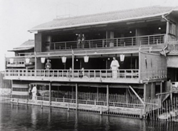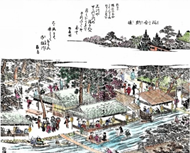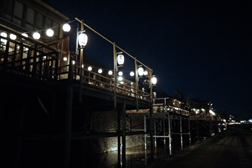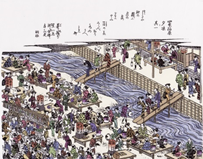Eco house of Kamo-river’s Yuka The latter part
Eco house of Kamo-river’s Yuka (Bench that people are siting for drinking eating and cooling)
| Kamo-river The cool evening breeze in Edo era
|

Kamo-river Yuka in Taisho era at Minokichi |

The cool evening breeze in Edo era at Karasunomori |

Current cooling evening breeze |
The Kamo-river, which runs through Kyoto City, is also a river where we can fish for sweetfish, and it has been said that there is the custom people spent in evening breeze in the Kamo-river in the hot summer since the Heian period. It was started in the time of Hideyoshi Toyotomi that they began to line up the bench in the river. It has been reported that wealthy merchants began to line up a bench in the shallow waters of Gojo-dry riverbed to entertain visitors in the hot summer of Kyoto.
In the early Edo period, around 1662, Yuka (Bench for enjoying the evening cool) was recorded as an annual event in Heiankyo. In the Edo period, Tadasu-no-Mori was also used as Yuka in the Edo period, and it was called Tadasu-no-Suzumi.
The evening breeze of Shijo Kawara is from June 7 to June 18 (the lunar calendar) and the period before the Gion Festival (Sakino Festival).
Tadasu-no-Mori is feld from June 19 to the end of the month and It was done according to Nagoshi-no-Harae (Summer festival for repellent disaster).
The Kamo-river Yuka is a hospitality that uses the cooling breeze of the river in the evening since the Edo period. At that time, there seemed to be a lot of river sandbars and they passed the boards to river sandbar and river sandbar and drived in a nail to plate around Shijo of Kamo-river.
The number of townspeople had gathered for seeking cooling breeze at the river side in the summer season and stalls started to appear with the aim of crowding, Tokoroten, candy etc were sold, and river fish saller on the west bank also began selling river fish as for souvenirs, tea houses carry tea and alcohol, duck. The Yuka event of cool evening breeze of the riverbank has became established.
In such an era, rich wealthy merchants, instead of Shijo, seek their area and place them in a place like in gojo’s riverbank , laying boards and floors on both banks, and carrying dishes from caterers. they bring liquor etc. to entertain visitors. It can be seen in pictorial drawings, etc., where it is placed in a shallow water and the cooling evening breeze is sought.
“ Hinamikiji : book written the daily event in it ” (1677) states, “ Let’s line up floors and set up seats with spread all over the land and land of Shijo Riverside ”
“East and west teahouses’s lanterns are set up are set up, and it is as if it were a white nights and as if cooling evening breeze event “.
The times have advanced, revetment work has progressed, and stilts have been shifted to enjoy the scenery, and safety measures against floods and disasters have also been taken.
In Japan, there has been a history of overcoming the heat and cold with various innovation goods, creating an ice room using the cold, and donating ice to the Emperor in the summer. In the hot summer days, the Kyomachiya style was designed so that the wind could escape from the street garden in a good way to create a breeze. In 2019, the MLIT revised and encouraged the Building Energy Conservation Act (MLIT). The times change, but we want to preserve the energy-saving habits of Kyoto.

